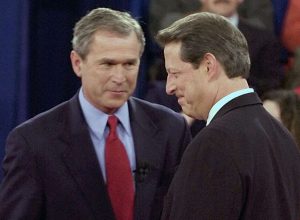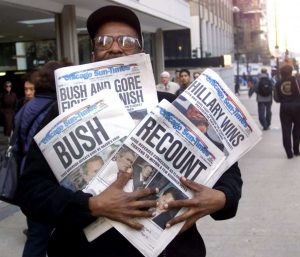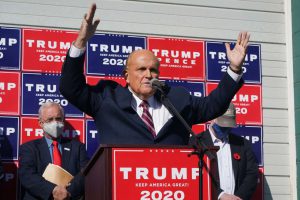NOVEMBER 9, 2020

Texas Gov. George W. Bush greets Vice President Al Gore at Washington University in St. Louis on Oct. 17, 2000. – LAURA RAUCH/AP
WASHINGTON, D.C. – Around 2:30 a.m. on Nov. 8, 2000, Democratic presidential candidate Al Gore had called his Republican opponent, George W. Bush, to concede, and he began making his way to the War Memorial Plaza in Nashville, Tenn. to address his supporters.
Gore retracted his concession only an hour later. And networks retracted their projections that Bush had won Florida’s 25 electoral votes. By the time the sun rose, the presidency remained undecided. Bush was ahead by only 1,784 votes out of about 6 million cast in the state, a very narrow margin that triggered an automatic recount.
What followed was five tumultuous weeks of back-to-back legal fights that reached the U.S. Supreme Court. Gore pushed for manual recounts in certain counties; Bush pushed back against them. By December, the high court ruled 5-4 in Bush’s favor to stop the manual recounts. The final tally had Bush ahead by just 537 votes.
What happened two decades ago is far from what’s happening now in 2020, legal experts say.
In 2000, the outcome hinged on just one state: Florida. A win in the Sunshine state would push either candidate toward victory. In the end, a difference of only a few hundred votes was key to deciding the presidency, and this very narrow margin allowed both sides to fight aggressively over every ballot.
In 2020, President-elect Joe Biden is ahead by thousands of votes in five battleground states where President Donald Trump’s team is pursuing legal action to challenge the results. The closest state, Georgia, which will hold a recount, still has Biden ahead by 10,620 votes as of Monday at 3:03 p.m.
A recount is unlikely to change the outcome given the current margins. Claims of widespread voter fraud – which have not been backed by evidence – affect a miniscule number of votes, experts say.
“Basically, the election is over. There isn’t anything that has come out that could plausibly affect the outcome,” said David Boies, who led Gore’s legal team in 2000. “There’s no legal avenue for the Trump campaign to plausibly dispute the results in any one state.”
Boies acknowledged that the Trump campaign is entitled to recounts. But, he said, “recounts are going to affect hundreds of votes, maybe. They’re not going to affect thousands of votes.”

President Donald Trump’s supporters remain committed, though former Vice President Joe Biden leads.
‘Very, very narrow’ path to the U.S. Supreme Court
Trump, who has shown no sign of conceding, has repeatedly expressed his desire to lean on the U.S. Supreme Court, to which he has appointed three conservative justices, to tip the election in his favor.
But the path to the high court is “very, very narrow,” Boies said.
For the Supreme Court to be involved, there must be a federal or constitutional issue. Issues that have been raised so far, including allegations of voter fraud and not giving Republican poll watchers meaningful access to closely watch the counting of ballots, are all local or state issues over which the Supreme Court has no jurisdiction, Boies said.
“It is unlikely that any issue, any plausible issue, that could go before the court would really affect the outcome,” Boies said. “And I think that particularly in the absence of a determinative issue, the Supreme Court would be particularly reluctant (to be involved).”
Barry Richard, who represented Bush in 2000, agreed, saying the highly politically charged environment is unlikely to persuade the high court to intervene.
“I think the Supreme Court does not want to become involved in selecting the president this year. In multiple polls, the American public has shown that of the three branches of government, it’s the Supreme Court that the public has the highest regard for. I don’t think they want to lose that, particularly the chief justice, John Roberts,” Richard said. “I don’t think the court will take this unless they have to.”

In this Nov. 8, 2000 file photo, Willie Smith holds four copies of the Chicago Sun-Times, each with a different headline, in Chicago, reflecting a night of suspense, drama and changes in following the presidential race between Vice President Al Gore and Texas Gov. George W. Bush. – Charles Bennett, AP
For litigation over the 2020 election to reach the high court, there would have to be a repeat of 2000: an extremely tight race hinging on one swing state. Or, as Richard described, on two states, with each going a different direction.
There would also have to be legitimate constitutional questions.
In 2000, the Supreme Court looked at the issue of equal protection, which requires the government to treat individuals in the same way. There needed to be a uniform way of considering ballots during the recount and there wasn’t, which violated an equal protection right that voters have to have their ballots treated equally during an election. The court ruled that because Florida counties conduct recounts differently, continuing the recounts was unconstitutional.
In 2020, if local election officials had allowed poll watchers for one party to closely watch the counting of votes, but did not do the same for poll watchers of the other party, “there might be an issue,” Richard said.
But that’s not the case. There has been no evidence that poll watchers from both parties were treated differently. There’s also no evidence that ballots were counted improperly in favor of one candidate, experts say.
“I just think it’s two entirely different situations. And I think the federal courts have learned (from the experience of 2000) that the federal court should not intervene in the elections,” Boies said. “The presidency should be determined by the voters in the ballot box, and not in court.”
Conspiracy theory vs. factual evidence
In 2000, the Bush and Gore campaigns sent powerhouse lawyers to Florida, where they started collecting facts in multiple counties. Each legal team found what they believed to be discrepancies in the counting of votes in a race in which just a few hundred ballots could tip the results.
The controversy came down to very specific, technological issues. So-called “hanging chads” and “dimpled chads” became household terms.
Florida counties two decades ago used punch-type mechanical voting machines. Voters punch out “chads” – tiny portions of a paper ballot – using a small stylus to vote for their preferred candidate. If chads are punched out completely, the machines count those votes.
But in cases in which chads were hanging by one corner (a hanging chad) or were indented but still attached (a dimpled chad), counties have different rules on whether or not to count the votes. And each side fought “tooth and nail” over every ballot, said David Becker, executive director and founder of the Center for Election Innovation and Research.
“This was a highly complex, incredibly well-litigated dispute in one state over a few hundred ballots,” Becker said.
2020 is entirely different.
“The claims that have been made at this parking lot press conferences have not held any water in court or under scrutiny, and they’ve been rejected every time by the courts,” Becker said, referring to a press conference by Rudy Giuliani, Trump’s personal attorney, outside Four Seasons Total Landscaping. “This is litigation by conspiracy theory … It’s very different from Florida (in 2000) where both sides were litigating based on reams of factual evidence.”

Attorney for the President, Rudy Giuliani, speaks at a news conference in the parking lot of a landscaping company on November 7, 2020 in Philadelphia. – Bryan R. Smith, AFP via Getty Images
Trump said that “beginning Monday,” his campaign “will start prosecuting our case in court to ensure election laws are fully upheld and the rightful winner is seated.” Giuliani did not respond to a text message seeking details of plans on any additional lawsuits.
Where the 2020 lawsuits stand
Arizona: The Trump campaign has sued in Maricopa County, alleging Arizona voters were given Sharpie pens to mark selections, and when vote tabulation machines flagged some ballots as defective, poll workers improperly overrode the machines.
State elections officials have denied that ballots were tabulated improperly. They say Sharpies work best because they don’t smear or bleed through, which would cause voting machines to detect erroneous selections in a race. In a letter to Attorney General Mark Brnovich, Secretary of State Katie Hobbs’ office decried “Sharpiegate” as an “unfounded conspiracy theory.”
A hearing on the lawsuit was scheduled Monday afternoon.
Georgia: The Trump campaign and Georgia Republicans went to court the day after the election, alleging the Chatham County Board of Elections had improperly intermingled ineligible ballots with valid ones.
A judge dismissed the case the next day for lack of evidence after the county elections head said he reviewed all 53 ballots in question and concluded they had been received before the deadline on Election Day.
Michigan: A Michigan judge threw out a Trump campaign lawsuit last week seeking an order that the Secretary of State provide “meaningful access” for observers to watch ballot counting and allow it to view videotaped surveillance of ballot drop boxes.
The judge said the secretary had already issued a directive providing access to observers, the counting was complete, and there was no legal basis to provide videos. The judge dismissed as hearsay an affidavit from a Republican poll watcher in Detroit alleging she heard about a date on a ballot being improperly altered.
The Trump campaign is appealing the case.
Nevada: Republicans have brought cases in state and federal court alleging problems with software used to match signatures on mail ballots, but judges declined to stop vote counting.
A lawsuit arguing campaign observers had inadequate access to monitor ballot counting was settled after the parties agreed they would have more access.
The Nevada Republican Party has asked the Department of Justice to investigate its allegation that about 3,000 nonresidents cast ballots in the state. Clark County Registrar of Voters Joseph Gloria said he would look into the allegation, but he said it’s common for out-of-state voters to cast ballots, including those serving in the military, university students and elected officials serving in Washington, D.C.
Pennsylvania: The Trump campaign, the Republican Party of Pennsylvania and others have filed a flurry of lawsuits and legal briefs about the controversial three-day extension for voters to return mail ballots, the rights of people to observe ballot counting, and the process for “curing” ballots when mistakes are made.
Arguably the most consequential cases involve challenges to a Pennsylvania Supreme Court decision that upheld a three-day extension of the deadline for accepting mail and absentee votes.
Opponents of the extension have argued it was unconstitutional because it sidestepped the Pennsylvania lawmakers who enacted the deadline in 2019. The Secretary of State’s office has argued the extension was a reasonable accommodation for voters given the coronavirus pandemic and mail delays.
The Pennsylvania Supreme Court upheld the extension, but said ballots received after Election Day should be segregated and tallied separately.
The Republican Party of Pennsylvania has asked the U.S. Supreme Court to order county election boards to segregate and take no action on mail and absentee ballots that were received after Election Day.
However, the Pennsylvania Secretary of State said in a Supreme Court filing that all election boards had kept late ballots separate and tallied them apart from other ballots.
A case over ballot-counting monitoring is headed to the Pennsylvania Supreme Court. The Trump campaign argued that one of its observers was kept too far away from ballot counting in Philadelphia.
A trial-level court ruled there had been no violation of the state’s election code, but an appeals court overturned that and directed that observers be allowed within six feet, subject to COVID-19 protections. On Monday, Pennsylvania’s Supreme Court agreed to consider an appeal of that ruling.
Courtesy/Source: This article originally appeared on USA TODAY










































































































